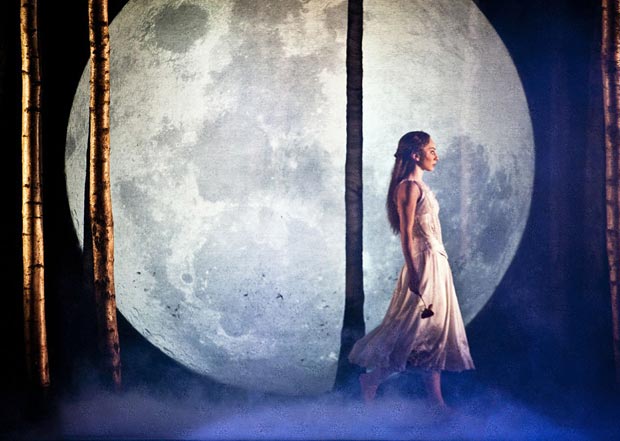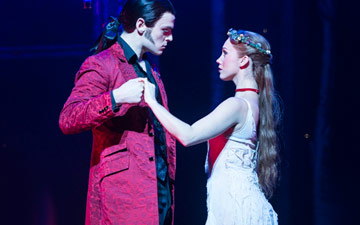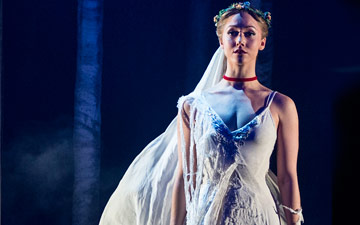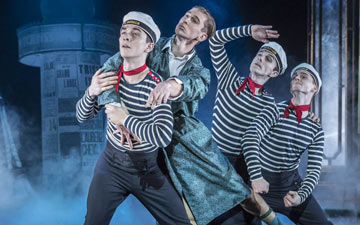
© Simon Annand. (Click image for larger version)
Mathew Bourne / New Adventures
Sleeping Beauty, A Gothic Romance
New York, New York City Canter
24 October 2013
www.new-adventures.net
www.nycitycenter.org
Vampiric Beauty
So, Matthew Bourne has completed his Tchaikovsky trilogy, a project that began in 1992 with his Dickensian Nutcracker and peaked in 1995 with his strikingly original Swan Lake. Now he’s taken on Sleeping Beauty, the most delicate and difficult of the three. Despite its sumptuous score and glorious set pieces (the fairy solos, the “Rose” adagio) it’s a ballet that seems to elude even some of the best ballet companies. Most versions seem either to get lost in the fine print (like American Ballet Theatre’s) or to streamline the story into oblivion, robbing it of its symbolism. Because, in reality, Sleeping Beauty is not really a love story, but a story about symbols, manners, and order. Its climax is not the prince’s kiss (which comes as almost an afterthought) but the wedding scene, when majestic order is restored. Not unintentionally, Tchaikovsky closed the ballet with a salute to monarchic power, the seventeenth-century march “Vive Henri IV.”
But that’s not Bourne’s way. As with his Swan Lake, he has reinvented the story for our times. His version (of Swan Lake) offers a prince caught between an overbearing mother and a demanding “official” bride which some have claimed hints at the lot of Prince Charles. Bourne’s Prince wanted out of his superficial world; the lake and its sensual male swans provided the ideal escape. For the most part, the transformation worked, and the predatory, hissing male swans were their own reward. Alas, his Sleeping Beauty (subtitled, “A Gothic Romance”), despite some good ideas (especially in the first act), is nowhere near as inspired. In attempting to impose a cohesive narrative on what is essentially an allegory (with some pretty character dances thrown in), he has hopelessly warped the ballet’s fairy-tale logic, requiring desperate measures to tie up loose ends. Vampires cannot fix this mess.
As in other Bourne shows, the designs are a source of visual pleasure. For the opening scene, Lez Brotherston has created a sumptuous Victorian gothic world full of drapery and dominated by an oppressive, oversized moon. (In contrast, Petipa’s prologue was set in the reign of Louis XIV.) The costumes for the fairies (who turn out later to be vampires), are elegant and ragged, perfectly suited to the ambiance. The Edwardian country-house setting of the second scene, Aurora’s birthday party, is just as handsome, tastefully fitted with white dresses and parasols. (I particularly liked the detail of the weeping statue in the foreground.) Then, after the princess’s hundred-year slumber, the action moves to a nightclub, a den of debauchery in the style of Eyes Wide Shut, all red velvet and masks. There are other clever design elements as well: a hidden conveyor belt that allows the dancers to glide through space in arabesque; a bunraku puppet representing baby Aurora, crawling about the palace.

© Simon Annand. (Click image for larger version)
Hannah Vassallo, who danced the role of the teenaged Aurora on October 24th, convincingly conveyed Bourne’s idea of Aurora as a wild child, a frantic free spirit who can’t stand corsets or stockings or boring garden parties. And Chris Trenfield revealed just the right innocence as the royal gamekeeper (Leo) who turns out to be Princess Aurora’s playmate and true love. Both are dynamic, un-affected, tirelessly energetic dancers, running, leaping, skittering, and sliding about the stage with abandon. Bourne’s choreographic style (based in ballet, but without ballet’s formality) may not be particularly focused or specific, but it has a pleasing exuberance. The best pure-dance passages come in the first act, in the balletic solos for the fairies and the spirited social dances – waltzes, proto-tangos – of the party scene. For the balletomanes, there are little quotes from Petipa in the choreography for the fairies. Unsurprisingly, these connect well with the music. (They are, however, no improvement on Petipa.) It’s also a nice touch to mix together male and female fairies. Similar steps, different qualities. (None of the dancers are on pointe.) The Lilac Fairy, or rather Count Lilac – is played by a man, Christopher Marney. Mr. Marney, delicate and fine-boned, has a beautiful line and moves with filigreed precision.

© Simon Annand. (Click image for larger version)
But the dancers can’t save the show. The first act is relatively convincing, despite some rather campy acting and chaotic reordering of the score. Throughout, the music is played at an unpleasantly loud volume, with blaring bass. “Forget ballet! This is scary!,” Bourne seems to be telling us. But from the moment Count Lilac sinks his fangs into Leo in order to keep him alive (or at least “undead”) for the next hundred years, all bets are off. The second act begins with a group of enthusiastic tourists snapping pictures of each other outside of Aurora’s castle – why? The twists and turns become increasingly preposterous, until we end up with Aurora lying defenseless on a couch, surrounded by revelers performing unconvincing, almost comical gyrations, setting the stage for a ritual sacrifice. How did we get here? In terms of narrative coherence, this is no improvement on Petipa. Worse yet, throughout this act, Tchaikovsky’s music is mostly ignored, used as lush but undifferentiated background noise. Gone are the charming fairytale dances that enliven the ballet’s final scene – replaced by aimless, herky-jerky nightclub moves – and the climactic pas de deux that Tchaikovsky’s music so clearly asks for. It turns out that Sleeping Beauty’s storybook logic is not so easily adaptable after all. The vampires are more a distraction than an addition. For all Bourne’s imagination, his version makes even less sense than the original.
Sleeping Beauty, A Gothic Romance runs through Nov. 3.

















Just to clarify, the over-amplified music is not played live, but in a recorded version.
M
[…] With Sleeping Beauty, Bourne completes his Tchaikovsky Trilogy. Not satisfied to delve into its plot, he has reconstructed the story and added some rather surprising supernatural elements. Does it work? Not really. Sleeping Beauty is not an easy work to stage–even ballet companies, following Petipa’s libretto, often fail. But by going hors-piste, Bourne is forced to make increasingly outlandish choices to keep the story on-track. The first act more or less works, but the second goes off the rails. Meanwhil, Tchaikovsky’s music (played in an overloud recording) is more or less trampled. Here’s my review, for DanceTabs. […]
Dear Marina,
I enjoyed your review. However, I knew before it opened, that I had no interest in wasting my money to see Bourne’s version.
Thank you for your review.
Best,
Barbara Thau
PS I do receive your comments and posts.